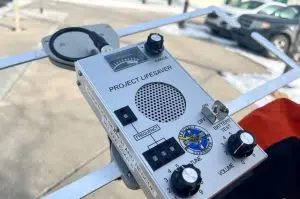It can be a family’s worst nightmare — a loved one who suffers from dementia walking away from their care home or residence, or a child wandering away and leaving their parents with no idea where they could be.
It has happened dozens of times in Saskatoon, but families who are members of “Project Lifesaver” can rest a little easier. The program turns five years old this year, according to Sherri Denis, an instructor and member of Saskatoon Search and Rescue (SSAR).
“Time is of the essence,” said Denis. “The reality is, it gets cold here, especially at night, so we look at all of those things, as it validates for us why we do this important work.”
The program is based out of West Virginia, and while several Canadian cities take part, Saskatoon is the only participating city between Winnipeg and Surrey, B.C.
Denis said the program was a project of former SSAR president and Saskatoon police officer Shelley Ballard-McInlay.
“Her dad had dementia and she was really looking for something to keep him safe, because he was vulnerable and very much wanting to wander away from care,” said Denis.
After a 2017 conference in Winnipeg, and a lot of fundraising and training, the program launched in Saskatoon the following year.
“Vulnerable people are at risk of wandering, and because they are vulnerable, their life is in danger,” Denis said. “So if this is a way that you can find and locate people that much quicker, it helps for sure.”
More than 100 clients have gone through the program and 43 are current members. Every client wears a special transmitter either on their wrist or on their ankle, and SSAR members have special receivers which they can tune to each individual person’s transmitter frequency.
“When we get called by Saskatoon Police Service on a search for our clients, we confirm the frequency that they are wearing in their transmitter bracelet and then we activate our team, let them know what frequency they are looking for, and so they can start searching from the moment they leave their homes,” she explained.
It all runs on FM radio waves instead of GPS satellite signals.
“We don’t track our clients. We only look for them in the event of a search,” Denis added.
When a client is reported missing, SSAR members start from the missing person’s last known location. The goal is to find them in 30 minutes or less.
“The first member that gets the first signal will do a 360, try to get a direction, and then they’ll notify the other teams that are also approaching the area which direction they believe the signal is. The other teams will triangulate and come from other different ways and then we try to zone in on the client,” Denis explained.
So far, searchers have successfully located every single person who has gone missing while wearing a transmitter. Denis said on one occasion it took two hours to find a man who’d left his care home and returned to his old apartment building. On another occasion, they saved a woman who’d become severely hypothermic.
“This was in March of last year,” Denis said. “We were able to do very careful first aid and hypothermic care for her until paramedics arrived. This absolutely saved her life that night.”
Program start-up costs are around $20,000 for equipment, plus transmitters at $440 each, additional training costs, and continuing education. Denis said Search and Rescue Regina is currently looking at initiating the program as well.
More information on the program and requirements can be found online.













